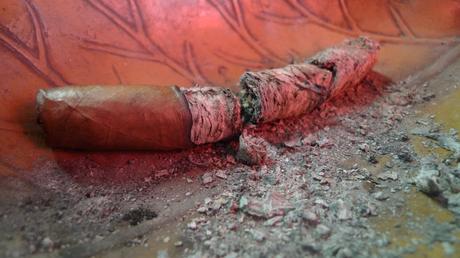
Flatiron #2 / Martinez Hand Rolled Cigars, New York, NY / Leica D-Lux 4
In the neighbourhood of the Flatiron Building, a foreign culture has been absorbing the New York district since 1974. Bedded six streets and two avenues away from the iconic architecture, the Martinez tobacco factory is a representation of the Dominican cigar hand rolling tradition. Six days a week the torcedores begin the day by starting and finishing hundreds of cigars in the production process, then end the day with a simple version of the Mexican ‘Michelada’ – a beer topped with tomato juice.
Four blends have been created within the main production of this small tobacco establishment, catering to the demanding taste of cigar aficionados. Two lines were blended by the founding father, Antonio Genaro Martinez (1947 – 2002), and two by his son, Jesús Martinez. The Flatiron line was blended by the latter.

Flatiron #2 / Martinez Hand Rolled Cigars, New York, NY / Leica D-Lux 4
A Flatiron is a flatiron, not a torpedo vitola. Asking Jesús as to the reason for a Flatiron, he expressed his intention to honor the surroundings that have contributed to their local and global success. Needless to say, the science and culture of a Dominican cigar production have not been changed by being in the center of New York City, but an impression has taken place and the repercussions open further possibilities to the cigar world.
Dressed in a natural Ecuadorian wrapper with filler and binder from Nicaragua, the cigar named Flatiron #2 is box-pressed and measures six inches by a fifty-two ring gauge. Its strength is perceived as medium to full body. Optically beautiful, it has an even, parchment-like, not too veiny surface, in a lightly roasted coffee hue. Its consistency is firm and, exemplifying the effort the four rollers of the company put into each stick, the seams are invisible.
Taking note of my experience and observations lighting six Flatiron #2 samples, supplied me with a list of references to chocolate, cinnamon, sweet ammonia, toasted bread, cedar, Nordic spices, herbs and church incense – all by slightly lighting the foot of the cigar. Into the first third I was reminded of African coffee, dark chocolate and leather. Strong earthy and nutty notes came afloat that reminded me even of almonds.
The draw throughout is very comfortable – not too light, not too tight.
Through and through the palate rejoices in a complex tobacco taste with plenty of character to be absorbed. Towards the second third the coffee and chocolate prevail, along with a fine, complex tobacco density of taste. Crossing over to the last third, there is more of a tobacco taste that clearly points out to the obvious: tobacco leaves are a vegetable. Vegetables are the one great thing I rediscovered the last few months. Through my cigar tastings I have suddenly become aware of the fact that smoking cigars is nothing more than a very different form of ingesting vegetables.
The creation of the Flatiron Cigar line points to the notion that cultures cannot be stagnant. Even the most conservative society is subject to progression and disintegration. Under a naturally incessant process, all culture shift and develop in some way, for they are not immune to our collective and individual experiences. Traditions benefit and/or suffer even under the most subtle changes. All things new become assimilated and the inherent subsides to adjustments.

A Flatiron #2, almost smoked into complete ashes / Martinez Hand Rolled Cigars, New York, NY / Leica D-Lux 4

